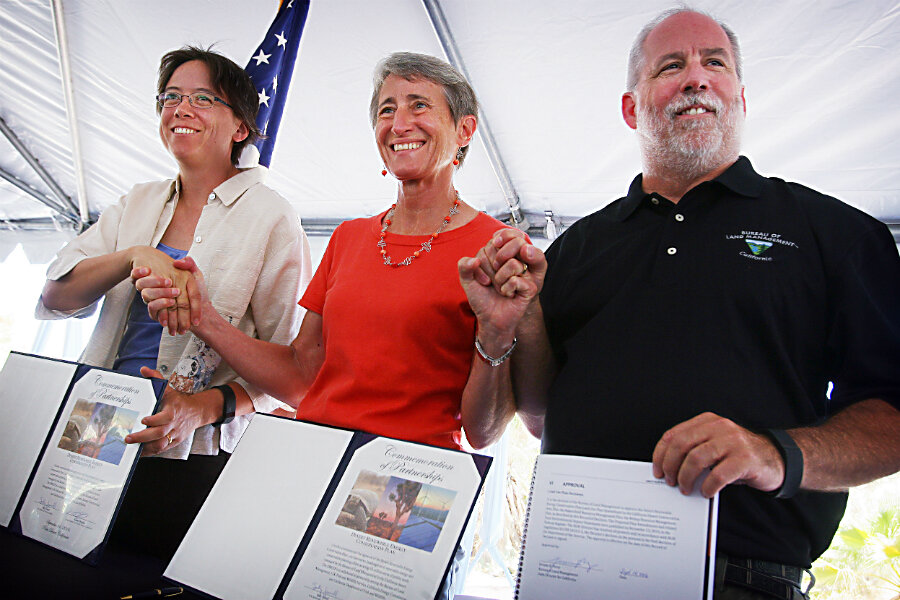Federal-lands rule pits green groups against wind, solar firms
Loading...
| Washington
The wind and solar industries are embroiled in a regulatory skirmish with an unlikely foe: environmental groups.
The industries worry a coming change in access to federal land will make it costlier and more difficult to develop renewable energy projects – the very ones Americans are welcoming as an antidote to emissions blamed for climate change.
Yet environmental groups, some of the biggest fans of renewable energy, are defending the proposed Interior Department changes. They say the new rules will protect wildlife and actually speed approvals for energy projects.
It’s too soon to say how the regulatory changes will play out, but the stakes are considerable. The changes may affect, for example, whether Democratic presidential nominee Hillary Clinton can honor a pledge to increase renewable projects on public lands and waters tenfold if she wins the White House.
The rule, coming as soon as November from the Bureau of Land Management (BLM), aims to offer land for competitive bidding between companies, much like current oil and gas leasing on federal lands. It’s a departure from the first come, first serve application process for “right-of-way” access that has guided renewable energy projects.
“Our companies know and for the most part like the current system,” says Christopher Mansour, vice president of federal affairs with the Solar Energy Industries Association. “They’re not clear how [the rule change] will impact their ability to push their permits through, and any uncertainty affects their ability to go to investors.”
A development boom
In fact, the change comes as renewable energy has boomed under the existing BLM framework. Before 2009, BLM hadn’t ever approved a federal solar project and hosted just a smattering of wind power. Since then, the agency has approved about 15,000 megawatts of wind and solar power. Much of that is owed to sharply falling prices, particularly for solar photovoltaics, though some also credit a recent BLM initiative to pre-approve large areas of the West for solar.
As BLM sees it, the coming alteration will make sure the ablest and most motivated developers secure projects rather than just those who file an application first. It promises to also boost federal revenue, as it pushes land costs closer to marketplace values.
And the goal is also to streamline permitting. The agency will do site-testing for solar and wind energy potential, as well as determining potential conflicts with endangered species, before offering land for lease.
"[The current system is] more predictable for them, but it doesn't always mean you have the project that’s with the most motivated developer,” says Dylan Fuge, counselor to BLM Director Neil Kornze. “I think what experience shows is some of those developers are ready to go, but others were not in that position. They were more speculative plays that tied up the public lands.”
But renewable companies contend the new process will make securing federal projects more cumbersome and expensive. In fact, by design, a competitive process is likely to boost bidding prices. Mr. Fuge says it will help the agency “efficiently allocate resources.”
The agency says the competitive bid process will help pay for some of its early legwork that will get projects up and running faster. In turn, that will lessen the burden and expenses for companies that must currently conduct and prove their own environmental case. BLM also says it offers more cost certainty. In the current system, the agency can alter the rental rates developers pay at any time, which could have consequences if, say, a new White House decides to increase or decrease rates.
“One thing we are hearing from industry over the years is they want consistency,” says Alex Daue, assistant energy and climate director with The Wilderness Society. He calls criticism of the rule change “surprising ... because there is no predictability or consistency in the current system.”
Shifting fees
But the rule would also change the fees on rent and electrical capacity that solar and wind developers pay even after acquiring land through a competitive leasing process. The results are vastly different for the two energy sources.
Wind producers may have to pay BLM more. When changing the fee structure, BLM realized wind on federal land had been undervalued by 50 percent. The agency is looking at ways to soften the blow to wind firms as the fees adjust. For Solar companies, these fees would fall under the new pricing formula. Neither like the electric capacity fees to begin with, though, seeing it as a tax because they say generating wind or solar power doesn’t actually deplete a finite resource.
BLM says it’s offering some relief on the fees for developing in pre-approved areas. The draft BLM rule suggested fixing rental rates for 10 years. It also called for phasing in fees for each megawatt in a project over 10 years, and then fixing those fees for 20 years. Environmental groups also have recommended awarding bonuses for taking extra steps to prevent harm to wildlife, which BLM has implemented in other areas.
Industry objections to the new system in some ways echo views of fossil-fuel companies before them. Similar to oil and gas firms, solar and wind developers say the federal government can’t properly assess the needs and desires of private companies. They question the agency’s ability to identify attractive land and say too much of it is checkerboarded by questionable assessments of wildlife conflicts.
“What we have concerns [with] is when you start drawing a map and making regulatory decisions based on lines drawn,” says Tom Vinson, vice president of federal regulatory affairs with the American Wind Energy Association.
So far, the agency’s experience with setting aside plots of land for renewable energy development is a mixed bag.
It’s held two auctions for so-called “solar energy zones,” which may serve as a test run for the competitive leasing rule. One in Colorado’s San Luis Valley in October 2013 garnered zero bids, an outcome that both environmental groups and developers say was probably linked to the absence of nearby electrical infrastructure.
The other, in July 2014, in Nevada’s Dry Lake solar energy zone netted $5.8 million in high bids for six parcels across 3,083 acres. BLM approved the three projects last May and one is under construction.
“It was very successful,” says Barbara Boyle, senior campaign representative with the Sierra Club. “They’ve already developed at least 11,000 acres on federal land – developed or projects are in construction. I see no barrier.”
Those are just two of the 19 solar energy zones BLM has established. The agency says the process reduced companies’ environmental-review costs, since BLM did that work ahead of time. And in the case of the Dry Lake solar energy zone, BLM told prospective developers what they’d need to pay up front to mitigate environmental damage.
That doesn’t mean, however, that developers are in the clear after winning a bid, says the solar industry’s Mr. Mansour says, noting other procedural hurdles that opponents could exploit to delay projects.
“While you may have done some of the pre-work, there’s still plenty of opportunities for groups that don’t want to see any energy or any solar on federal lands,” he says.
California success or cautionary tale?
Renewable energy groups point to a recent BLM decision in the California desert as reason for concern. They participated for eight years alongside environmental groups and state agencies as BLM drafted a Desert Renewable Energy Conservation Plan. But they say the plan didn’t provide enough contiguous land to make large solar and wind projects economical. The industry worries that a similar effort to set aside sage grouse habitat in the West could block off large swaths of land.
Vinson says the California scenario is “concerning” because he sees BLM as trying to use that process as a “template” for establishing renewable energy development zones through the new rule.
That’s precisely what the Natural Resources Defense Council thinks would be a good thing. Bobby McEnaney, the group’s deputy director for western renewables, says the California model offers numerous incentives that can reduce the costs and delays for developers for siting projects in desirable areas with fewer wildlife conflicts.
“We’re very supportive of the zone process, because the zone process tries to eliminate as many of those vulnerabilities,” he says.
Fuge says the California and sage grouse plans “should be considered in the unique context under which they were undertaken.” The sage grouse plan was initiated in an effort to avoid an endangered species listing. The California format involved sensitive desert landscape, national parks and monuments, and native tribes. He added that in the California plan, developers can still build projects on 880,000 of 10 million acres, which he said would support 27,000 megawatts of solar power.
Renewable energy producers, however, disagree with that estimate.
“BLM does the best that they can, I get it. But they’re not developers,” says Mansour. “You’re looking at kind of being micromanaged by the people in the Bureau of Land Management.”








